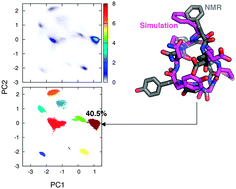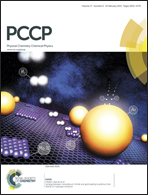Toward structure prediction of cyclic peptides†
Abstract
Cyclic peptides are a promising class of molecules that can be used to target specific protein–protein interactions. A computational method to accurately predict their structures would substantially advance the development of cyclic peptides as modulators of protein–protein interactions. Here, we develop a computational method that integrates bias-exchange metadynamics simulations, a Boltzmann reweighting scheme, dihedral principal component analysis and a modified density peak-based cluster analysis to provide a converged structural description for cyclic peptides. Using this method, we evaluate the performance of a number of popular protein force fields on a model cyclic peptide. All the tested force fields seem to over-stabilize the α-helix and PPII/β regions in the Ramachandran plot, commonly populated by linear peptides and proteins. Our findings suggest that re-parameterization of a force field that well describes the full Ramachandran plot is necessary to accurately model cyclic peptides.


 Please wait while we load your content...
Please wait while we load your content...